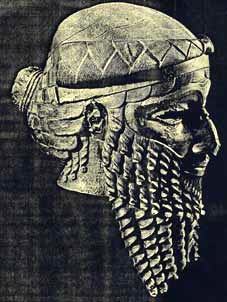HEAD
OF A BRONZE STATUE
OF KING SARAGON OF AKKAD

In 2400
BC the Sumerian King of Uruk, Lurgalzaggisi, had united the
Middle East into one great empire from the Persian Gulf to the
Mediterranean. He ruled it for 25 years. Then a junior officer,
a Semite, Sargon of Akkad, revolted. He captured Lurgalzaggisi
and exhibited him in a cage at the gate of the temple of Enlil
at Nippur. Sargon and his descendants ran the united empire,
thereafter called the empire of Sumer and Akkad (2370-2285 BC).
Sargon and his grandson Naram-Sin, one of the greatest oriental
rulers, were both called king of the four regions, which the
Cambridge Ancient History properly allows to be a claim for
the universal dominion over the whole earth. The detailed evidence
suggests that Sargon and his descendants were in fact continuing
a tradition of contact and trade with the America’s and
the Far East.
From The
Art of Ancient Mesopotamia by Anton Moortgat
New
World/Old World Links Index
|